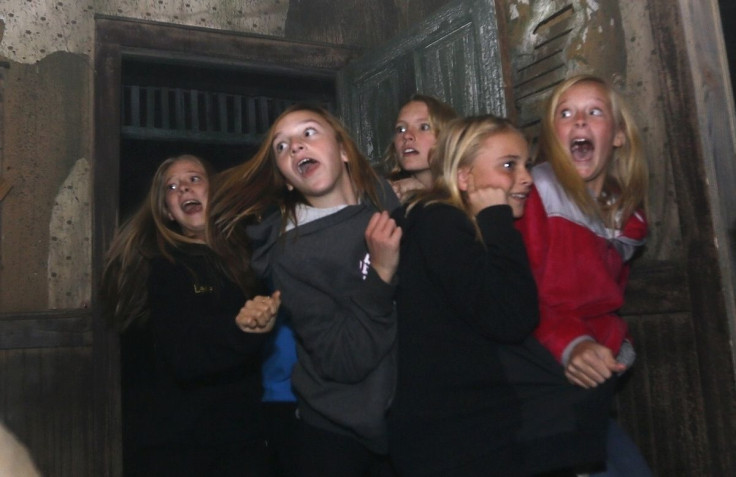It’s A Happy Halloween In 2013 For The Big Business Of Scaring Americans

Halloween is now the second-largest commercial holiday in the United States and, from the candy to the costumes and decorations, a much bigger business than one might think. It’s bigger than the sales of pumpkins, chocolates, masks and makeup. In fact, it’s the holiday’s ghoulish symbol, the haunted house, that’s actually one of its greatest success stories.
The National Retail Federation believes more than 20 percent of Americans will visit a haunted house in 2013. Larry Kirchner, owner of the popular website HauntWorld.com, said what they can expect to find different this year is a resurrection of the kind of places popularized in 1980s and 1990s B films. “We’re seeing an interesting trend this year with haunted houses as they look to bring in visitors. A lot of old-fashioned creepy themes are making a comeback, with a resurgence in scary clowns, old schoolhouses and haunted motels,” he noted.
The other big trend this year ensures that, though the destinations may have a retro feel, the experience will be one that’s state of the art. “Haunted house owners are going over the top,” Kirchner said. Their attractions are “bigger, better and scarier than ever because they’re no longer competing with only other haunts in the area, but with haunted houses across the country.”
Kirchner figures the top 13 haunted attractions on HauntWorld’s 2013 list alone cost more than $1 million to construct -- and they’re expected to bring in more than $1 billion in revenue thanks to advanced special effects, cutting-edge animatronics, and dazzling pyrotechnics and explosions.
“Visiting and traveling to haunted houses is now an American phenomenon,” he said.
Rival Halloween website AmericanHaunts estimates that there are more than 1,200 haunted attractions that charge admission fees across the U.S., with an additional 3,000 or so charity attractions run by local organizations, which open for only a single day or single weekend around Halloween. Among haunted attractions that charge admission, each averages about 8,000 paid guests who will fork over roughly $15 per event.
It’s not just haunted houses that profit from the annual October fear fest. AmericanHuants believes there are now more than 300 amusement parks offering some sort of Halloween or haunted house event.
Next to Christmas and the peak summer travel season, Halloween is the third-busiest time of the year for theme parks, bringing in roughly 10 to 15 percent of a park’s total annual revenue. This, of course, is no small feat, as October falls in a typically slow time for most businesses between the end of summer and Thanksgiving. But the chance to get spooked in a safe environment gives visitors a tantalizing motive to buy a ticket -- one that most often comes with a hefty price tag and isn't included in a season pass.
Six Flags runs a Fright Fest at 13 of its parks every Friday, Saturday and Sunday in October, while Universal Studios offers what is, perhaps, the most elaborate Halloween makeover at its complexes in Orlando and Hollywood. In its 23rd year, Universal has tapped into popular TV series, movies and video games for inspiration, including “The Walking Dead,” “The Cabin in the Woods,” “Evil Dead” and "Resident Evil."
Busch Gardens, SeaWorld, Disney Parks and others all offer similar Halloween events throughout the month of October.
A 2010 survey from the International Association of Amusement Parks and Attractions found that 87 percent of its members -- which include representatives from theme parks, water parks, museums, zoos and aquariums -- planned to offer Halloween attractions and events. Some 52 percent said the Halloween events would target families with young children, while 32 percent would target both families and thrill-seekers. Almost half of the respondents, meanwhile, said they started planning for Halloween more than six months in advance.
The survey indicated that Halloween-themed events at parks and attractions really took hold in the mid-2000s. Only 38 percent of parks and attractions offered fall activities prior to 2000, while another 20 percent joined the trend by 2005. The rest, about 42 percent, offered their first Halloween-themed event between 2005 and 2010.
These figures coincide with the overall rise in popularity of Halloween over the past decade. According to a survey from the National Retail Federation, Americans will spend $7 billion on Halloween in 2013, while two-thirds of people plan to actively celebrate the holiday or participate in related activities. Meanwhile, Americans spent just $3.3 billion on Halloween in 2005, and only 50 percent actively took part.
© Copyright IBTimes 2024. All rights reserved.






















